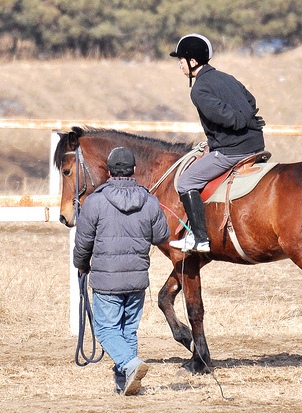|
Keep Riding

|
| Learning to ride in Beijing |
The Wenyu river is a surprise in
many ways. Walking by the river, with open countryside stretching in all directions, downtown Beijing seems to be much
further away than the 20 minutes drive it would normally take from the Jingmi Lu bridge (that’s up to 60 minutes
during the rush hour mind you). Now unfrozen, hundreds of water birds, recently arrived from the south, fly
around in raucous bands when disturbed by dog-walkers, a shepherdess and her sheep; or indeed by off-road cyclists and joggers
from the nearby “expat compounds”. The foreign-influence
in these upmarket housing estates is on the wane, however, as more and more locals move up the property ladder and in to the
area, replacing the expats whose China adventure has come to an end. But, despite the changing ethnicity of the local villa-dwelling
population, jogging and bike-riding by the Wenyu River remain the preserve of the “laowai” (or "old-outsider",
the most-often heard Chinese expression for foreigner). After all,
why ride a BMX by the river when you can drive a BMW to the golf course? Let’s face it, bike riding in Beijing is a pursuit that millions are
striving to avoid. Horse-riding, though, is in a completely different
league.
There is a large equestrian
centre by the Wenyu River – one of the reportedly 60 or so that has opened in Beijing – that, judging by the standard
of horsemanship on display, caters more for the beginner than the seasoned rider. If I were to take a stab at the make-up of their clientele, I would say that the vast majority are under
35 and that two-thirds are female. No matter what the level of the rider – not that I am qualified to judge –
all are equipped with the “right gear”: stylish breeches and riding boots (most probably bought from the tack
shop that’s on Jingmi Lu - aka Jingshun Lu). Horse-riding, it seems, it as for much for fashion lovers as it is
for horse lovers. This is confirmed by Sherry
Kuang – a new fan of horseriding – who was interviewed by the China International Business (CIB) magazine (Feb
10th) for its article “Ready to jump the
hurdle”: “China’s ambitious professionals see in horse riding something that combines fashion and sport,”
she tells the magazine.
Interestingly,
Ms Kuang, a “28-year-old accountant”, bought her stuff from the aforementioned Jingmi Lu tack shop and, according to CIB magazine, spent
“RMB 300 (USD 43.90) on her breeches, RMB 400 (USD 58.50) on a protective jacket and RMB 1,400 (USD 204.75) on boots”. Then there’s the cost of the horse-riding
sessions themselves of course: a block of ten hour-long lessons cost Ms Kuang 2500 RMB.
Just to repeat, I’m
far from expert on these matters but, although the magazine article doesn’t mention it, the shopping list would surely
have included a hat. The only other thing I know about horseriding is that riding at speed without holding the reins
is asking for trouble. And that's exactly what I saw through my camera's viewfinder as the shrill scream of a woman
diverted my attention from taking photographs of a flock of seven Smew (a type of duck). I watched in horror as
what I can best describe as a bronking mule tried to unseat its lady rider, who was fighting a losing fight to
keep her balance by using her arms in the manner a tight-rope walker might when about to lose her footing
above a swirling torrent of water.
Although
I was a few hundred metres away, the picture below clearly shows the poor girl about to hit the ground.
The way she fell was horrifying; and I was expecting the worst after she lay motionless for several minutes. (The picture
also shows the concerned looks of four of the bystanders, who also looked over when they heard her scream.)
I am very happy to report however that, miraculously, ten minutes later she sat up. A few minutes after that she rose
to her feet and, incredibly, in five more minutes she got back on the very same horse that had unseated her.
Now that's what I call courage. The admiration - not to mention relief - of the bystanders was palpable.
The incident offers a clue as to why a series of “Keep Walking” TV commercials by Johnnie Walker has resonated
so well here among young professionals – many of whom are feeling particularly vulnerable during these uncertain
times. The moral of the storyline is that, no matter how bad things are, and how many knocks you take, real courage
manifests in the ability to pick yourself up, dust yourself down, and use the bad experience to your long-term advantage.
I’m looking forward to seeing the lady in the picture on my future walks (or bike rides)
by the Wenyu River – and I wouldn’t be at all surprised to see her becoming one of the centre’s star riders.

|
| Fall before the pride |
|

